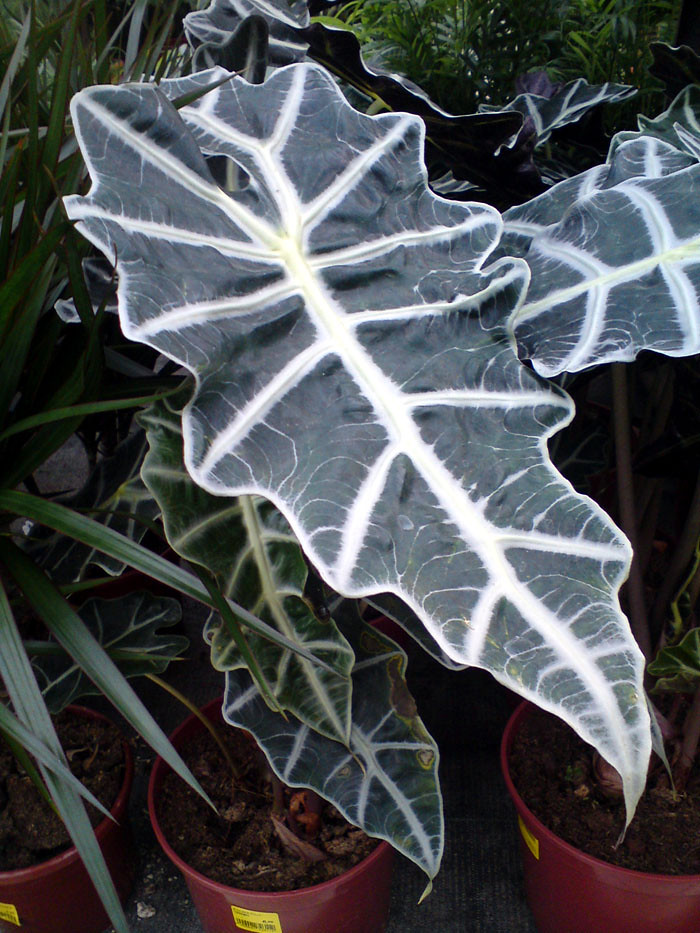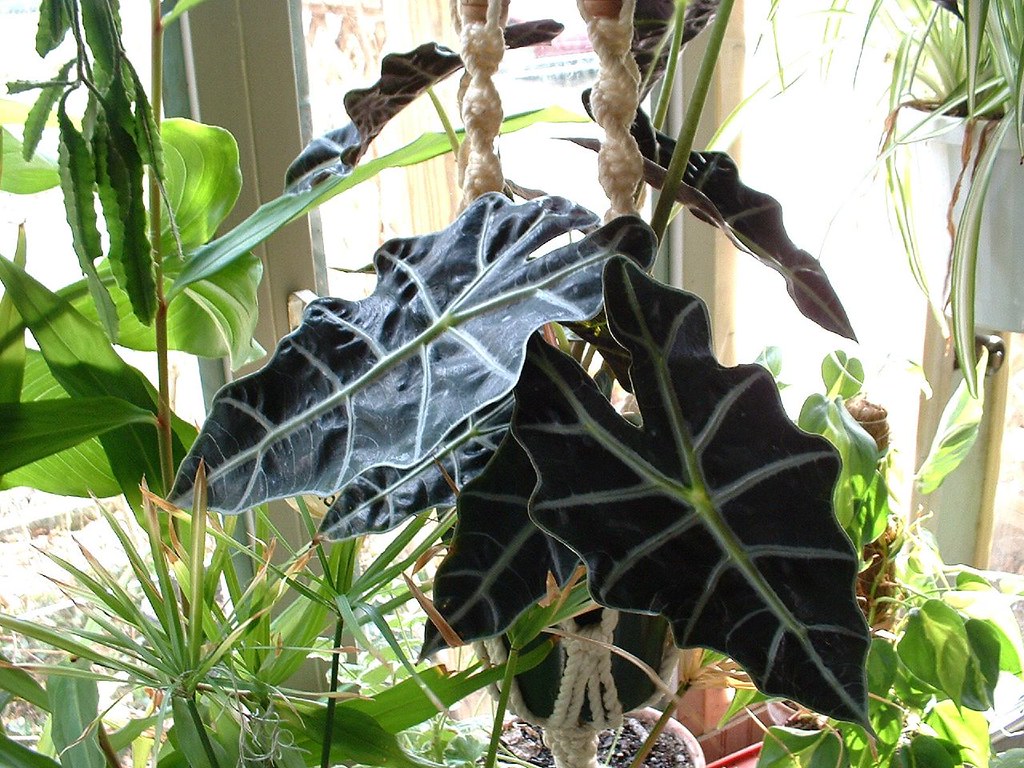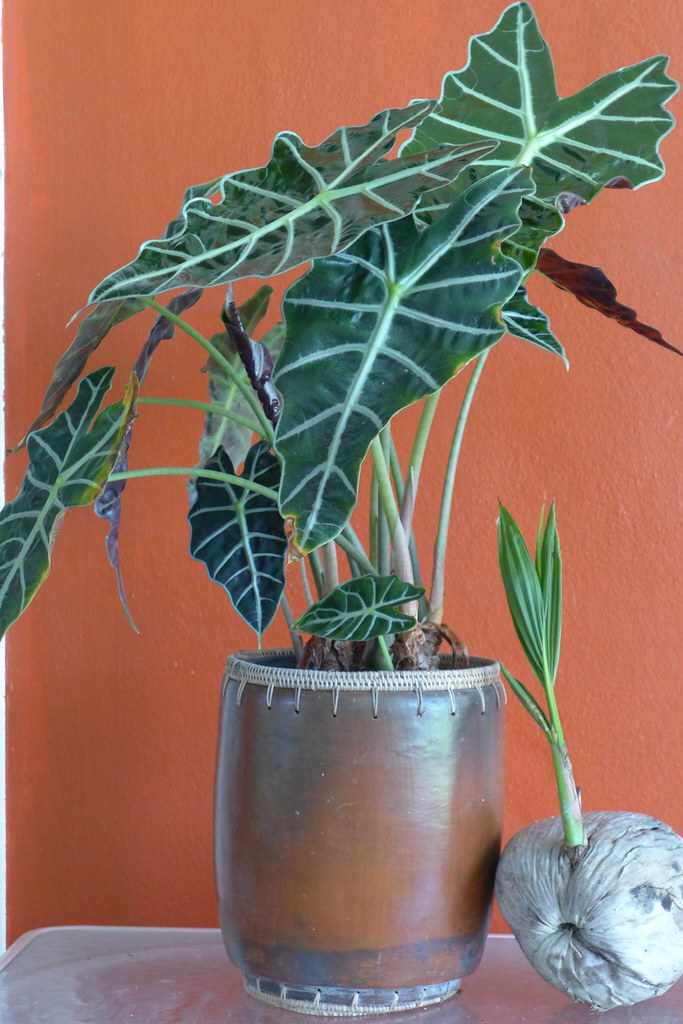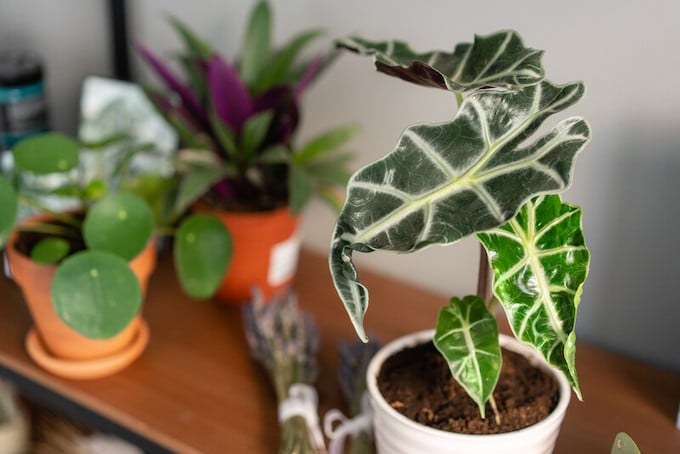Have you heard about plants named African Mask Plant? or if you plant geek, you may name it alocasia polly? Well, it is a very interesting plant. You may ever be seeing it somewhere in the indoor room or your backyard garden. To be short, it’s a green color with big-love-shape leaves and has beautiful leaves segment across it. Curious to know? let’s get into more detail.
What Is Alocasia Polly?

The Alocasia Polly or also known as the African Mask Plant, Elephant Ear, Amazonia Taro is native to subtropical Asia and Australia. Alocasia Polly is not a very easy plant to grow since it needs a lot of things to take care of. Once you can provide all their needs, it is absolutely worth buying.
People called it Elephant Ear or African Mask Plant because it has big leaves with dark green color and shaped like an arrowhead, also the silvery color for their veins. Aside from that, the alocasia Polly plant doesn’t like direct sunlight. They are sensitive to sunburn.
The best way to keep the distance from the sunburn is to put them behind a curtain or window if you put it indoors. Also, the right amount of humidity will keep them on the best growth.
For the difficulty to grow them, the elephant ear plants might not the best choice for a beginner to start their gardening. However, it is still possible if you really will care about their needs.
Alocasia Polly Plant’s Varieties

In-plant world, there are around 70 species of Alocasia Polly. These plants are primarily hybridized, because of their leaf, form, color, and size. The famous varieties of these plants are :
Alocasia x Amazonia
This type of alocasia is a hybrid that has wavy-edged, arrowhead-shaped, and also green dark bronze leaves. The leave can reach up to 16 inches long. This is the most hybrid with features leathery.
Alocasia Sanderiana
This type has a very dark green color and it has an exotic look. An Alocasia Sanderiana has long, pointed white veins on its leaves. A. Sanderiana reaches 12 – 16 inches, is about 30 – 45 cm long, and 6 – 8 inches (15 – 20 cm ) wide. Beside that, the rhizome of A.Sanderiana also known as rootstock, and the shape are vertically placed.
The unique thing about A. Sanderiana is the female flower’s plant will grow at the lower part of the plant and the male flowers are at the top of the plant. For this type, they have fruits, orange-red berries but it is not edible for anything.
Alocasia Macrorrhizos
It is known as the biggest or Giant Taro of this plant. This type can grow up to 15 feet tall and eight feet wide with leaves and can reach three to four feet for the length and two – four feet for the width.
An A. Macrorrhizos was originally found in the Philippines but also known from the wild world in Taiwan. It spread outwards to the rest of Southeast Asia countries and eastward to Oceania. For this type, their leaves and stems are edible if you cook it the right way. Also same as other types of Alocasia, it causes itchiness if we bite or scratch it on our skin.
From the most three famous Alocasia Polly, to grow all of them, you have to keep it warm, moist, and humid. Always trim away their faded leaves.
How To Grow Alocasia Polly

Grow Amazonia Taro plants is not easy. They really need a lot of things to be concerned about, such as :
Light
For this part, Amazonia taro / Alocasia Polly needs indirect sunlight. It will grow perfectly if you didn’t put them to low light or direct sunlight. Putting them behind the curtain also will be a perfect step to help block out the sunlight especially during the mid-day. Too much sunlight will cost them scorch leaves.
Water
It needs frequent misting and also weekly watering. Keeping their soil moist but not wet at all, will fulfill their needs. If you live in a cold country that has a winter season, the best way to keep them alive is to dry out the top of the soil when you watering it.
This will prevent overwatering and root rot. For watering, this plant need to has such a perfect amount of soil and water or it will change their leaves color to brown.
This tropical plant needs quite a bit of water. It has thick stems that help them to store moisturizing the stems by themselves. In this way, Amazonia taro doesn’t rely on soil for its moisture. So, the conclusion is you don’t have to water your plant when the soil is dry.
There is an amazing trick for watering the plant itself. Since it doesn’t need to be watered too much, you can lift up the pot once you watered them and from there, you can fill the weight of your Amazonia Taro / Alocasia Polly, it will feel heavy.
After this step, wait until few weeks and lift up your Alocasia Polly’s pot again, if it feels lighter, then you absolutely know that you have to water the plant again. With this trick, you will figure it out easily and on time when your plant needs watering.
Humidity :
A perfect location for Alocasia Polly is a greenhouse where you can absolutely control the humidity and temperature the plant needs. Aside from that, you can also grow them inside your house.
The humidity for this plant is the most important thing you have to take care of. They need a perfect moist air condition. Putting them nearby with other plants will help to create more humidity for them.
To create humidity for your plant, you can do this step :
- Put the Alocasia x Amazonica’s pot or container on a tray of pebbles. The next step once you watering the pebble, the tray will catches dan retains the water. This will create the right amount of humidity for your plant.
- You can fill up a bottle with water and use it as a spray bottle and mist the plant’s foliage every once or twice a week.
- If you put your plant somewhere indoors, let the plant get the right amount of light to get proper growth. Especially if you put them as a bathroom decoration, every time you use the tap for the water, it will create humidity.
Temperature :
This plant comes from tropical countries. It means that the Amazonia taro plant will not grow or die if you put it under low temperatures. For this plant, you need 18 – 25 degrees Celcius. Also, if you put them indoor, a spot under an A/C is definitely not a good spot for Amazonia. Keep them not dry and warm will be a perfect decision.
Fertilizer:
Since alocasias grow quite quickly, the right seasons for doing fertilizer in spring to summer. You have to do this once a month in their growing period. Highly suggested to stop feeding them once it is in the winter season or dormant period of the plant.
For feeding them, you can do it using a liquid fertilizer or fertilizing sticks. If you decide to use fertilizing sticks, be aware of the instruction since it will affect their growth. Usually, fertilizing sticks will last for around 100 days, so u don’t have to do it once a month anymore, only 3 – 4 times a year.
Fertilizing your plant is better without using a strong blend of fertilizer because you might end up burning the foliage. If this happened, it will cause your plant cant to grow perfectly and losing nutrients because of the burning.
How To Care Alocasia Polly?

An Alocasia Polly can be easily be propagated in water because it is a semi-aquatic plant. During the plant’s dormancy, you have to move it somewhere warm and reduce the watering as is mentioned in the How to Grow section until it starts growing again in the spring season.
For indoor, growing Alocasia Polly really needs a perfect warm environment, humidity, and damp soil. For outdoor, you have to bring it back inside when it comes to the winter season or if you have a greenhouse, make sure that you keep the temperature right and warm for the plant.
Potting and Repotting

For Alocasia Polly repotting the plant is usually into a larger pot but not more than one size bigger and make sure that is free-draining potting soil. Aside from that, divide the rhizome to keep and manage the size of the plant is the best decision. This way, you can make a lot of collections of elephant ear plants or Alocasia Polly plants.
Potting and repotting Alocasia Polly depends on how the robustly grows. For this case, you might no need to do repotting for several years because sometimes there is no reason to do this as long as you keep changing the soil.
The steps for doing repotting for Alocasia Polly are :
- Gently remove the plant from the pot to inspect and make sure that it all completely wrap. After this step, gently tease them apart with your fingers and not a sharp metal.
- Fill the pot or container with soil. This should be around a quarter of the way full of the pot or container’s size. Then settle it with the right amount of water.
- Put the plant on the pot or container and not too deep so it will grow naturally and perfectly.
- Fill the remind part of the pot or container with soil and wrap it around the plant.
- Give water to wet the soil a little bit and make sure it has bottom drain holes since the soil has to be dry out fastly.
Once you decide to do repotting, there are several important things you have to take note of, such as :
- Don’t do repotting to more than one size bigger than the previous pot or container. Because once you do that, it might cause a soggy and too wet of soil on the plant itself that makes the plant didn’t grow well.
- Make a hole in the bottom of the pot to keep the soil drying out quicker. Highly suggested to use a pot made of plastic for the material.
- The best soil for repotting is quick-draining soil. Using heavy soil is not good and usually will remain too wet and will create a rotting rot for the plant.
The last information about potting and repotting is the best time to do it is when in the spring season.
Propagating Alocasia Polly Plants
The rhizome has mostly propagated the plant. With this such of fact, you have to cut off the bottom part of the rhizome and put it on the other pot. The next step is you have to keep the rhizome to stay warm and moist until it grows into a new alocasia polly.
Pests
The A. Polly is really rare for getting pests and disease. Although, sometimes some insects are interesting to come especially spiders. So, you have to regularly check if you have to clean them gently without harming the plant. To do this, do it very quickly and easily so the plant will not give you any bad response and keep growing normally.
Troubleshooting :
Here is indicate when your elephant ear plant has a problem on the growth :
- If the leaves change the color to yellow or have a yellow spot, you have to reduce the watering. This happened because it is overwatering. For this case, make sure that you give enough soil and allow the topsoil to dry out before the next watering. You have to do this, especially in winter.
- If the leaves are fading and dying in the winter season, it means that the temperatures are drop. Alocasia Polly needs a warm temperature. This might happen during the dormancy period. If this is happening, reduce your watering and set the temperature to the right degrees is the best solution.
- Have browning edges means the plant is either been scorched by direct sunlight or is underwater. In this case, don’t let your plant suffer under direct sunlight and move them somewhere with indirect light.
Is Alocasia Polly Poisonous?
The Alocasia Polly plants contain insoluble oxalate crystals which most of the Araceae family has as well. This really poisonous for pets and kids. For your pets, if they bite or chew the leaves, amazonica or alocasia polly will release this crystal and cause some effects such as difficulty to breathe, mouth irritation, swelling.
When this happened, you have to bring your pets to the vet. This affects also gonna happened with kids. The best way is to put Alocasia Polly in a place where both pets and kids can’t reach.